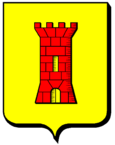Rimling
| Rimling | ||
|---|---|---|

|
|
|
| region | Grand Est | |
| Department | Moselle | |
| Arrondissement | Sarreguemines | |
| Canton | Bitche | |
| Community association | Pays de Bitche | |
| Coordinates | 49 ° 6 ′ N , 7 ° 16 ′ E | |
| height | 281-392 m | |
| surface | 13.26 km 2 | |
| Residents | 650 (January 1, 2017) | |
| Population density | 49 inhabitants / km 2 | |
| Post Code | 57720 | |
| INSEE code | 57584 | |
 Main street with the post office on a historical postcard |
||
Rimling ( German Rimlingen ) is a French commune with 650 inhabitants (as of January 1, 2017) in the Moselle department in the Grand Est region (until 2015 Lorraine ). It belongs to the Arrondissement of Sarreguemines and the Canton of Bitche .
geography
Rimling is located in the rural western Bitscher Land in the catchment area of the Bickenalb , at the foot of a ridge made of shell limestone, about halfway between Sarreguemines and Bitche . The hamlet of Morainville (German Schönhof ) in the far west of the district belongs to Rimling .
history
Finds show that the area was already settled in the Bronze Age . The place was first mentioned in the 8th century as Remingilas . In the year 855 the name Rymelingen appears. Charlemagne is said to have given the rights to the site that was a royal estate to the Hornbach monastery . From the year 865 there is a confirmation of these rights by Lothar II . During this time, Rimling was the administrative headquarters for the Bliesgau , from which the Bitsch rule eventually developed. Under this, Rimling was the place of jurisdiction and mayor's office for numerous, in some cases far more important, towns today. From 1790 to 2015, Rimling belonged to the canton of Volmunster , which no longer exists , and since then has been part of the canton of Bitche.
Two important medieval trading routes crossed in Rimling: the Duser Strasse from the Lorraine saltworks area from Marsal via Zweibrücken to the Rhine and the Lombardische Strasse from Flanders via Strasbourg to Italy. A third street branched off here to St. Ingbert . The dukes of Lorraine built a castle to protect them in the 11th century. Over time, the importance of the place declined, but it remained the customs and toll station of the Bitsch rulership as well as a relay and quarter station on the trade routes. The castle was damaged in 1397 and is only described as a larger farm in 1570, at the end of the Bitsch rule. In 1525 Hans Zoller from Rimling was one of the leading figures among the Lorraine farmers in the Peasants' War . He brought 8,000 farmers together in the Herbitzheimer Haufen. After initial victories, almost all of them perished in the great Zabern massacre . In 1774, Pierre Mercenier donated the funds to build a hospital. As a result, there was a scandal because the abbot, who was entrusted with the administration of the foundation, embezzled considerable funds and the hospital never went into operation. Among other things, a school was housed in the buildings. In memory of Pierre Mercenier, the municipality of Rimling named a street after him. At the end of the Second World War , Rimling was hotly contested. In the course of the fighting there were numerous casualties and property damage. On December 13, 1944, US troops took the town for the first time. From Christmas on, Rimling was then under heavy German fire and from January 7th to 10th, parts of the 17th SS Panzer Grenadier Division captured the village back during Operation Nordwind . On January 13, the SS took 15 men between the ages of 16 and 60 as hostages and kidnapped them to Zweibrücken, where they were tortured and harassed by the Gestapo . They were allowed to go home on January 20th. The names are all still known. On February 15, 1945, the US troops finally returned and finally liberated Rimling. Of the 1939 551 inhabitants, 393 were left, of 120 houses 59 had remained standing, practically all of the livestock were dead or stolen, and the area was completely mined.
Population development
| year | 1962 | 1968 | 1975 | 1982 | 1990 | 1999 | 2007 | 2017 |
| Residents | 467 | 467 | 484 | 488 | 464 | 494 | 509 | 650 |
Culture and sights
Around 20 Lorraine crosses have survived in the area. The most important from 1761 is located southeast of the town near Imswiese. Only terrain profiles of the castle on the Schlossberg are recognizable. It was converted into a farm in 1570 and completely destroyed in 1700. Good view of the place from the Schlossberg. The post office's insignia can still be seen above the carriage entrance of the former relay station.
regional customs
The custom of ratcheting is still alive in Rimling . It is the task of the local children up to the age of fourteen to replace the church bells by rattling during Holy Week. It was forbidden to ring the bell during Holy Week since the 7th century . First, on Maundy Thursday, the night bell rattles. On Good Friday the ratchet boys call three times to pray and three times to the ceremony of the cross . For the last time, on Holy Saturday morning prayer is rattled. Then the ratchet boys go from door to door, sing their traditional song and receive eggs, chocolate and, nowadays, often money.
Infrastructure
The Bickenalb school is located in Rimling, a pre-school and elementary school for the surrounding communities.
Personalities
- Nikolaus von Weis (1796–1869), Bishop of Speyer, born in Rimling
Web links
- Rimling (French)
